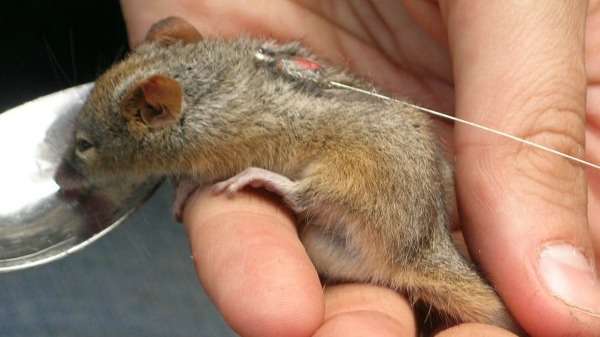Honey possum, with radio transmitter on its back, is being fed sugar water after being captured in a pitfall trap. Credit: Pat Dundas
Tiny marsupials endemic to WA's southwest show resilience in the face of disappearing food and shelter, a Perth study suggests.
Honey possums (Tarsipes rostratus) are the only flightless animals that eat only nectar and pollen of flowering plants, mainly banksias, eucalypts and heath.
Though abundant from south of Geraldton to Esperance, their fussy eating habits make the marsupial particularly vulnerable to the impact of plant pathogen Phytophthora cinnamomi, known as dieback.
An adult honey possum weighs about 9g – less than an Australian 20-cent coin – and consumes approximately 1.5 teaspoons of nectar and a small pea of pollen each day.
Dieback decreases the availability of nectar and pollen to honey possums, and other animals, as the soil-borne water mould infects susceptible plants.
This loss of food and refuge poses a threat to honey possums in affected habitats, according to Murdoch University honorary research fellow Dr Shannon Dundas.
Dr Dundas and colleagues Professor Giles Hardy and Associate Professor Patricia Fleming investigated how dieback influences honey possums' habitat use in Cape Riche National Park, 119 km northeast of Albany, in 2007.
Cape Riche was chosen because its "patchy mosaic" of dieback affected and intact vegetation is a known honey possum habitat, Dr Dundas says.
Tiny radio transmitters were glued to 18 honey possums to track their movements.
GPS co-ordinates for sites where the marsupials were captured and last recorded location were used to monitor the possum's travel routes.
Seventy-seven tracked honey possum locations were compared to 45 sites randomly selected by the researchers.
The presence of dieback clearly influences the marsupial's habitat use, with honey possums preferring taller, denser, healthy vegetation or pockets of plant species persisting within affected areas, Dr Dundas says.
"The animals show resilience in terms of how they make use of resources across the landscape, using the best habitat available within and around infested areas," she says.
"Honey possums were observed moving relatively long distances to visit food plants in flower."
The longest total distance traveled between recorded locations was 1400 m across 28 sites over nine nights.
The possum's noses were swabbed for pollen, which revealed five of the nine most frequently visited plant species were susceptible to dieback.
Dr Dundas says conservation management to prevent the spread of existing dieback infestations and minimise the contamination of disease-free sensitive sites is the key to protecting susceptible plant communities and the animals that depend upon them.
"Identifying honey possum food plant species that are resilient to the pathogen may support revegetation attempts," she says.
Their research was published in the Australian Journal of Zoology in August.
More information: Shannon J. Dundas et al. The plant pathogen Phytophthora cinnamomi influences habitat use by the obligate nectarivore honey possum (Tarsipes rostratus), Australian Journal of Zoology (2016). DOI: 10.1071/ZO16019
Journal information: Australian Journal of Zoology
Provided by Science Network WA
This article first appeared on ScienceNetwork Western Australia a science news website based at Scitech.
























